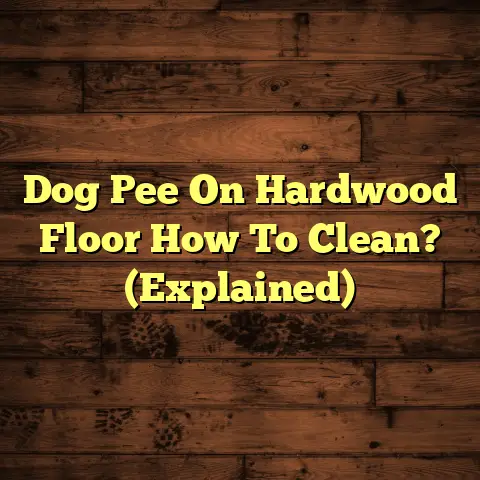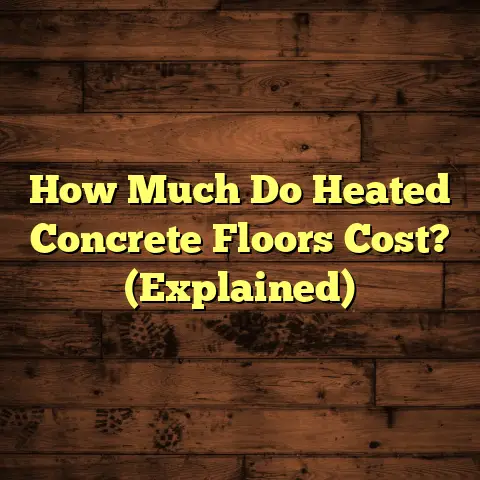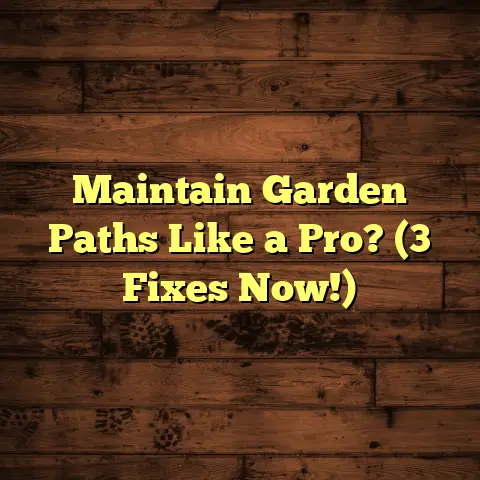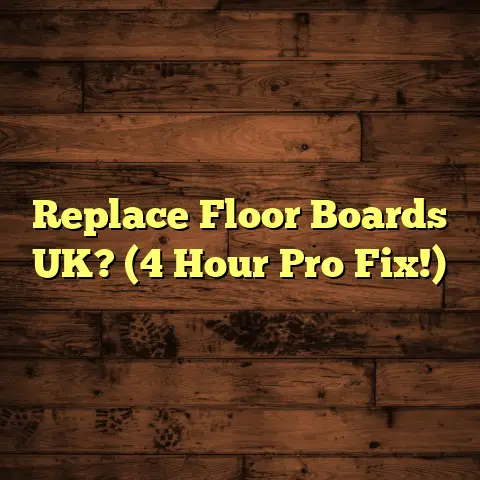Epoxy Floor Bubbles? (5 Minute Fix Guide!)
Imagine this: you’re stepping into your newly
renovated garage.
The gleaming surface of your
epoxy floor catches the light just right.
It’s a smooth and glossy finish that reflects your
effort and investment.
You’ve spent hours prepping,
applying coats of epoxy, and waiting for it to cure.
You’re proud of your handiwork.
But suddenly, your excitement wanes as you notice
unsightly bubbles popping up from beneath the surface.
Like tiny, unwelcome intruders on what was supposed
to be a flawless finish.
The sight of these bubbles,
some small and innocuous, others larger and more menacing,
sends a wave of frustration crashing over you.
What went wrong?
How can you fix it?
You feel a mix of disappointment and determination.
Well, let me tell you, you’re not alone.
I’ve seen this happen more times than I can count
in my years as a flooring contractor.
And the good news is, there’s a way to tackle
this issue head-on.
Let’s dive in and get those bubbles sorted!
Section 1: Understanding Epoxy Flooring
1. What is Epoxy Flooring?
Okay, so what exactly is epoxy flooring?
Simply put, it’s a flooring system made up of
two main components: epoxy resin and a hardener.
When these two are mixed, a chemical reaction occurs, resulting in a rigid, durable, and chemical-resistant plastic material.
Think of it like this: you’re essentially creating
a super-tough coating that bonds tightly to the surface
below.
That’s why it’s so popular for garages, basements,
and even commercial spaces.
Benefits? Here are a few:
- Durability: Epoxy floors can withstand a lot of wear and tear.
- Chemical Resistance: They resist spills and stains from oil, gas, and other chemicals.
- Aesthetics: They look fantastic, with a smooth, glossy finish.
- Easy to Clean: A quick sweep or mop keeps them looking brand new.
I’ve personally seen epoxy transform dingy,
cracked garage floors into showroom-worthy spaces.
It’s a game-changer!
2. The Curing Process
Now, let’s talk about curing.
This is a crucial step.
The curing process is where the magic happens.
After you mix the resin and hardener, you have a limited window of time (called the “pot life”) to apply the epoxy.
As the epoxy cures, the chemical reaction continues, hardening the material.
Temperature and humidity play a huge role here. Ideally, you want a temperature between 65°F and 80°F (18°C and 27°C) and relatively low humidity.
Why?
Because extreme temperatures or high humidity can
mess with the curing process, leading to problems
like bubbling, cloudiness, or even a sticky finish.
Common Mistakes?
- Mixing Improperly: Not mixing the resin and hardener thoroughly enough.
- Applying Too Thick: Applying the epoxy in a layer that’s too thick.
- Ignoring Temperature: Applying epoxy when the temperature is too hot or too cold.
- Ignoring Humidity: Applying epoxy when the humidity is too high.
I remember one time, I was working on a garage floor
in the middle of summer.
It was scorching hot, and the humidity was through
the roof.
I knew I was pushing it, but I figured I could get
away with it.
Big mistake!
The epoxy cured way too fast, trapping air and
creating a ton of bubbles.
I had to redo the whole thing. Lesson learned!
Section 2: Causes of Epoxy Floor Bubbles
1. Trapped Air
Alright, let’s get down to the nitty-gritty.
Why do bubbles appear in epoxy floors in the first place?
One of the biggest culprits is trapped air.
Air can get trapped in a few different ways:
- During Mixing: When you’re mixing the epoxy resin and hardener, you can inadvertently whip air into the mixture.
- During Application: As you’re rolling or spreading the epoxy, air can get trapped beneath the surface.
- From the Substrate: Air can be released from the concrete slab itself, especially if it’s porous or not properly sealed.
Environmental Conditions?
Hot temperatures can exacerbate this issue.
The epoxy cures faster, trapping air before it has
a chance to escape.
I’ve found that using a slow-speed mixer and taking your time during application can really minimize the amount of trapped air.
2. Moisture Issues
Moisture is another major enemy of epoxy floors.
If there’s moisture in the concrete slab, it can
interfere with the epoxy’s adhesion and curing process.
The moisture can react with the epoxy, creating gas
that forms bubbles.
It can also weaken the bond between the epoxy and
the concrete, leading to peeling or delamination.
Recognizing Signs of Moisture?
- Dark Spots: Dark patches on the concrete surface.
- Efflorescence: A white, powdery substance on the concrete.
- Dampness: A general feeling of dampness on the concrete.
I always recommend doing a moisture test before applying epoxy. More on that later!
3. Incorrect Application Techniques
Let’s be honest, applying epoxy isn’t as simple as
pouring it on and hoping for the best.
There’s definitely an art to it!
Common Application Mistakes?
- Not Priming: Skipping the primer coat, which helps the epoxy bond to the concrete.
- Applying Too Thick: Applying the epoxy in a layer that’s too thick, which can trap air.
- Working Too Slowly: Working too slowly, which allows the epoxy to start curing before you’ve finished applying it.
- Using the Wrong Tools: Using the wrong type of roller or squeegee.
Manufacturer Guidelines?
Always, always, always follow the manufacturer’s
instructions for mixing and application.
They know their product best!
I once saw a guy try to apply epoxy with a regular
paint roller.
It was a disaster!
The roller left behind a ton of air bubbles, and the
finish looked terrible.
4. Substrate Conditions
Finally, the condition of the surface beneath the
epoxy plays a big role in the final result.
If the concrete is cracked, dirty, or oily, it can
cause problems with adhesion and lead to bubbling.
Identifying Issues?
- Cracks: Cracks in the concrete can trap air and moisture.
- Dirt and Debris: Dirt and debris can prevent the epoxy from bonding properly.
- Oil and Grease: Oil and grease can repel the epoxy, causing it to bubble or peel.
I always tell my clients to thoroughly clean and
prep the concrete before applying epoxy.
It’s worth the extra effort!
Section 3: Diagnosing the Problem
1. Visual Inspection
Okay, so you’ve got bubbles.
Now what?
The first step is to take a good, hard look at your floor.
Step-by-Step Guide?
- Start with a general overview: Look at the entire floor to get a sense of the scope of the problem.
- Focus on specific areas: Pay close attention to areas where the bubbles are most concentrated.
- Note the size and pattern of the bubbles: Are they small and scattered, or large and clustered?
- Look for other issues: Check for cracks, peeling, or other signs of damage.
Size and Pattern? Small, scattered bubbles might indicate trapped air during mixing or application.
Large, clustered bubbles might suggest moisture issues or problems with the substrate.
2. Conducting a Moisture Test
As I mentioned earlier, moisture is a big enemy of
epoxy floors.
That’s why it’s so important to do a moisture test
before applying epoxy.
Simple Methods?
- Calcium Chloride Test: This is a professional-grade test that measures the amount of moisture vapor emitting from the concrete.
You can find these kits at most hardware stores. - Plastic Sheet Test: Tape a piece of clear plastic sheeting (about 1 foot square) to the concrete floor.
Seal all the edges with tape.
Wait 24-48 hours.
If there’s moisture present, you’ll see condensation underneath the plastic.
Understanding the Results? If the moisture levels are too high, you’ll need to take steps to dry out the concrete before applying epoxy.
This might involve using a dehumidifier, a fan, or even a concrete sealer.
According to the Portland Cement Association,
concrete moisture levels should be below 40% RH
(Relative Humidity) before applying epoxy.
(Source: Portland Cement Association, “Moisture in Concrete,” 2018)
3. Assessing Application Technique
Alright, time to put on your detective hat and review your application process.
Reviewing Your Process?
- Mixing: Did you mix the resin and hardener thoroughly enough?
Did you use the correct ratio? - Application: Did you apply the epoxy in a thin, even layer?
Did you use the right type of roller or squeegee? - Curing: Did you maintain the correct temperature and humidity during the curing process?
Checklist?
- [ ] Mixed the resin and hardener thoroughly
- [ ] Used the correct ratio of resin to hardener
- [ ] Applied the epoxy in a thin, even layer
- [ ] Used the right type of roller or squeegee
- [ ] Maintained the correct temperature and humidity during curing
If you can honestly check off all of these boxes,
then the problem might lie elsewhere.
But if you missed a step, that could be the source
of your bubbling woes.
Section 4: The 5-Minute Fix Guide
Okay, enough with the diagnosis.
Let’s get to the good stuff: fixing those bubbles!
Here’s my 5-minute fix guide for dealing with epoxy
floor bubbles.
1. Gathering Your Tools
First things first, you’ll need to gather your tools. Here’s what I recommend:
- Utility Knife: For popping small bubbles.
- Heat Gun: For releasing trapped air.
- Epoxy Repair Kit: For filling in larger bubbles or damaged areas.
- Sandpaper: For smoothing out rough spots.
- Clean Rags: For wiping up spills.
- Gloves: To protect your hands.
Right Tools? Using the right tools will make the job much easier and ensure a professional-looking repair.
Trust me, you don’t want to try popping bubbles with a butter knife!
2. Quick Fix Techniques
Alright, let’s start with the quick fixes.
These are best for dealing with small, isolated bubbles.
Popping Small Bubbles?
- Use a utility knife to carefully pop the bubble. Be careful not to scratch the surrounding epoxy.
- Wipe up any excess epoxy with a clean rag.
- If necessary, lightly sand the area to smooth it out.
Repairing Larger Bubbles?
- Use a utility knife to cut around the bubble, removing any loose or damaged epoxy.
- Clean the area with a clean rag.
- Mix up a small batch of epoxy repair kit according to the manufacturer’s instructions.
- Apply the epoxy to the damaged area, filling it in completely.
- Use a putty knife to smooth out the epoxy and blend it with the surrounding surface.
- Allow the epoxy to cure completely before walking on it.
3. Using a Heat Gun
A heat gun can be a lifesaver when it comes to
eliminating bubbles.
The heat helps to release trapped air, allowing the
bubbles to pop on their own.
How It Works?
- Hold the heat gun a few inches away from the surface of the epoxy.
- Move the heat gun slowly back and forth over the bubbles.
- Watch as the bubbles start to pop and disappear.
- If necessary, use a utility knife to pop any stubborn bubbles.
Safety Precautions?
- Wear safety glasses to protect your eyes.
- Use the heat gun in a well-ventilated area.
- Don’t hold the heat gun in one spot for too long, as this can damage the epoxy.
I’ve found that a heat gun works best on freshly
applied epoxy.
If the epoxy has already cured, it might not be as effective.
4. Reapplying Epoxy
In some cases, the only way to fix bubbling is to
reapply a new coat of epoxy.
This is usually necessary when the bubbling is widespread
or severe.
When to Reapply?
- When the bubbles cover a large area of the floor.
- When the bubbles are deep and difficult to repair.
- When the epoxy is peeling or delaminating.
Tips for a Smooth Finish?
- Sand the existing epoxy to create a rough surface for the new coat to bond to.
- Clean the surface thoroughly to remove any dust or debris.
- Apply a thin, even coat of epoxy using a high-quality roller or squeegee.
- Use a heat gun to eliminate any air bubbles.
- Allow the epoxy to cure completely before walking on it.
I know, redoing an entire floor sounds like a pain.
But trust me, it’s worth it to get a smooth,
flawless finish.
Section 5: Preventing Future Bubbles
Alright, you’ve fixed the bubbles.
Now, let’s talk about how to prevent them from
coming back!
1. Best Practices for Application
Prevention is always better than cure, right?
Here are some best practices for applying epoxy that
will help you avoid bubbling in the first place:
- Mix the resin and hardener thoroughly: Use a slow-speed mixer and mix for at least 3-5 minutes.
- Use the correct ratio of resin to hardener: Follow the manufacturer’s instructions exactly.
- Apply the epoxy in a thin, even layer: Avoid applying the epoxy too thick, as this can trap air.
- Use the right type of roller or squeegee: A notched squeegee can help to spread the epoxy evenly and release trapped air.
- Use a primer: Priming the concrete before applying epoxy helps to create a strong bond and prevent moisture from seeping through.
- Control the temperature and humidity: Aim for a temperature between 65°F and 80°F (18°C and 27°C) and relatively low humidity.
Environmental Conditions? If you’re working in a hot or humid environment, you might need to take extra precautions.
Consider working in the early morning or late evening
when the temperature is cooler.
You can also use a dehumidifier to lower the humidity.
2. Regular Maintenance
Finally, regular maintenance can help to prevent bubbles from returning and keep your epoxy floor looking its best.
Tips for Maintenance?
- Sweep or vacuum the floor regularly to remove dirt and debris.
- Mop the floor with a mild detergent and water.
- Avoid using harsh chemicals or abrasive cleaners, as these can damage the epoxy.
- Wipe up spills immediately to prevent staining.
- Inspect the floor regularly for signs of damage, such as cracks or peeling.
Spotting Early Signs? If you see any small bubbles starting to form, address them immediately using the quick fix techniques I described earlier.
The sooner you catch the problem, the easier it will be to fix.
Conclusion: A New Beginning
As you take a step back to admire your floor after applying these quick fixes, you feel a renewed sense of pride.
The bubbles are gone, and your epoxy floor shines like it did on day one.
You’ve not only learned how to fix an issue but also how to care for your investment.
With the right knowledge and techniques, you can ensure your epoxy floor remains beautiful and durable for years to come.
And remember, I’m always here to help if you run
into any more flooring challenges!
Happy flooring!





